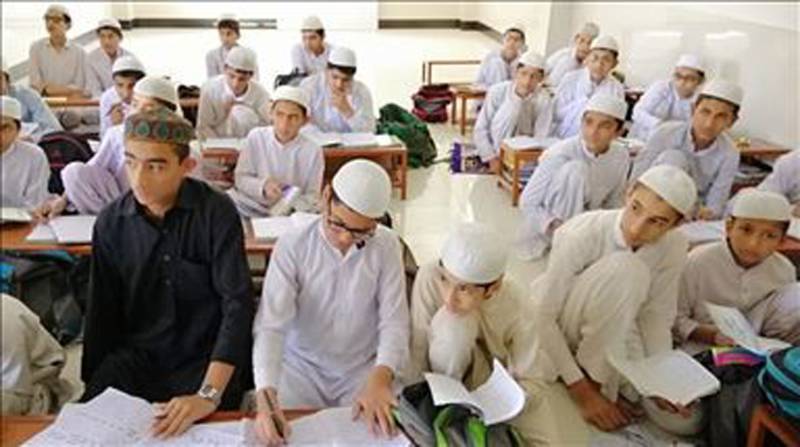ISLAMABAD - As part of strategy to dismantle the extremist networks, Pakistan government has decided to introduce major reforms in the curriculum of over 30,000 Islamic schools or madrassas dotting the country’s landscape.
Mostly privately funded and outside government purview, there had been a long-standing anxiety that they produce unskilled graduates, steeped in intolerant versions of Islam. The reforms would include banning chapters that are fueling hatred and introduction of modern subjects like science, skills and teaching of English language in the curriculum.
“The government will bear the financial burden to introduce these major reforms in madrassas which are a major source of education for poor children,” a senior officer in the Ministry of Education in Islamabad told Anadolu Agency. He said the religious leaders and the patrons of these institutions will be taken into confidence and included in the process of revising syllabus.
“These reforms will help madrassa students to graduate with modern skills. The step will also unveil vast career opportunities for them, at par with those graduating from colleges and universities.”
As per the plan, still under the formative stages, the government is preparing to post teachers to teach English, science subjects and skills in madrassas. Further the madrassas would be equipped with science laboratories.
While madrassas in Pakistan are often blamed for radicalization, they still continue to be the only outlets providing free religious education to poor children. Modeled on the pattern of boarding schools, they also offer free food and accommodation.
History of Madrassas - Official figures suggest that there were just 247 madrassas in Pakistan in 1947, at the time of country’s inception. Since then they have multiplied in geometric proportions.
Even before the Soviet-Afghan War that began in 1979 and lasted over nine years, the number of madrassas had grown to 2,831 in 1980s, during the tenure of military ruler Gen. Muhammad Zia-ul-Haq. Playing a key role in Afghan war, Haq declared it a jihad or holy war and organized Afghan Mujahideen to fight against the then world power. Besides, he also encouraged religious parties to step in and post their workers in the fight against Soviets.
“At the behest of religious parties, madrassa students took part in Afghan war, as it was declared a jihad,” Mukamil Shah, a resident of Dir, a town in Khyber-Pakhtunkhwa [KPK] province, told Anadolu Agency. Shah also participated in the war in 1985.
The number of madrassas increased as most of the religious parties set up their own seminaries fully under the patron and encouragement of the West, to provide education to millions of Afghan refugee children.
Teaching in madrassas - The curriculum currently being taught in the seminaries is called Dars-e-Nizami, drafted by an 18th century scholar Mulla Nizamuddin Sihalwi, from the Farangi Mahal madrassa, located in Indian city of Lucknow.
“We are teaching Tafseer [interpretation of the holy Quran], Hadith [saying of holy prophet Muhammad PBUH], Islamic law, Arabic grammar, Urdu language, memorizing of holy Quran and mathematics” said Mufti Munneb-ur-Rahman, a scholar in Madrasa Usmania situated in Nowshera, a city in the northwestern Khyber Pakhtunkhwa province.
Claiming that madrassas themselves have brought many changes in the system, he said his madrassa now teaches English, science and other social subjects. The critics of madrasa education system have often blamed that children graduating from these institutions are ill-equipped to face the modern world, thereby easily fall prey to militant outfits. “It is a baseless allegations,” said Rahman.
Replying to a question regarding the funding of these madrassas to meet their daily expenses, he said that they depend on donations and number of people from professions like medicine, engineering, business and even government officials offer zakat to these institutions.
Government reforms plan - Pakistan has been facing ample pressure from the western nations to regulate madrassas, as many of their alumni were accused of acting at the behest of extremist organizations, blamed for attacking the U.S. forces in Afghanistan and also fighting Indian forces in Kashmir.
The current Imran Khan’s government has banned several religious outfits and announced to bring reforms in madrassas in order to bring them under government control. However, the government is facing stiff resistance from powerful religious parties.
“Currently there are over 30,000 madrassas where over 2.5 million children are studying and government has decided to bring them in mainstream,” Maj. Gen. Asif Ghafoor, Pakistan Army’s spokesman, told reporters last month. He added that just 100 madrassas have been found involved in violent activities, while the rest are good and effective source of education for children. “We want to end violent extremism in the country and that will be possible when our children have the same education and opportunities,” Ghafoor added.
In February, Pakistan froze assets and took over the control of dozens of seminaries, mosque and other institutions believed to be affiliated with Jaish-e-Mohammad (JeM) and Jamat-ud-Dawah (JuD).
India had accused the JeM, a militant group, of being involved in an attack on its security convoy in Pulwama area of Indian-administered Kashmir in February. The attack killed over 40 security personnel. The JuD is accused of being involved in the planning of the 2008 Mumbai terrorist attack that killed over 150 people.






